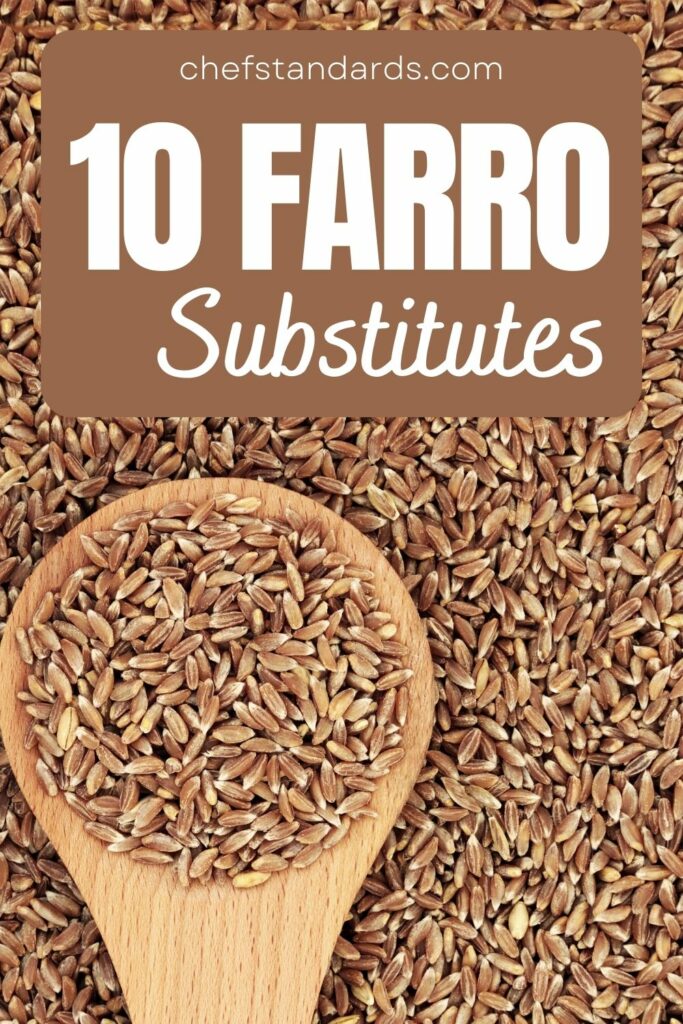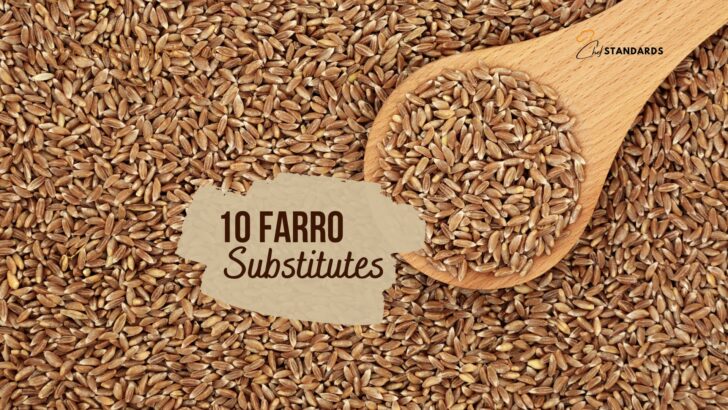Just like many other popular foods, Farro also originated in Italy and is the general Italian term for wheat.
It is quite nutritious and versatile and, if you choose pearl or semi-pearled varieties, it can be cooked very quickly and easily.
However, it is not so easy to find farro at the grocery store. Aside from that, some people are allergic to it, and farro also contains gluten, so it is not suitable for everyone. In those cases, alternatives can come handy.
So, in this article, I tried my best to provide you with the 10 perfect farro substitutes that certainly won’t disappoint.
1. Barley

Although there are many great options, in my opinion, barley is the best farro alternative, and that really isn’t a surprise considering that many experts say that farro tastes like a cross between barley and oats.
But of course, there are some downsides to this food that starts with b, so let’s look at the pros and cons of using barley as a substitute for farro.
Pros
• Availability: Unlike farro which can sometimes be difficult to find, barley is a highly available type of grain that can be found at most grocery stores and supermarkets.
• Cost-Friendly: Aside from being highly available, barley is also less expensive than farro.
• Flavor: Like farro itself, barley also has a nutty flavor with slightly sweet undertones, and, aside from that, it is a bit milder so you won’t have to worry that it will overpower your dish.
• Nutritional Profile: All barley varieties, especially highland barley grains, are rich in essential nutrients, with higher levels of fiber, protein, vitamin E, vitamin B, and magnesium.
Cons
• Texture: While both types of grains are chewy to some extent, barley is a bit softer, which may not be a good thing in some dishes that require a firmer texture.
• Cooking Time: Barley takes longer to cook than farro, so you may need to adjust the cooking time.
• Amount Of Protein: While both types of grains contain a fair amount of protein, barley has a lower amount, which may be a concern for those of you looking to increase your protein intake.
How To Use Barley
Since they both have a nutty flavor with slight sweetness, both are chewy to some extent and have a high nutritional value, farro and barley are quite interchangeable.
You can use barley as a substitute for farro in soups, stews, salads, and grain bowls. It will take a bit longer to cook and become tender and soft (around 40 minutes), but the result will be much the same.
You can freely use it in a 1:1 ratio when substituting.
Take note that there are three main types of barley: whole grain barley, semi-pearled barley, and pearl barley. Pearl barley is highly available and cooks faster, but it is also the least nutritious of these three options.
2. Quinoa
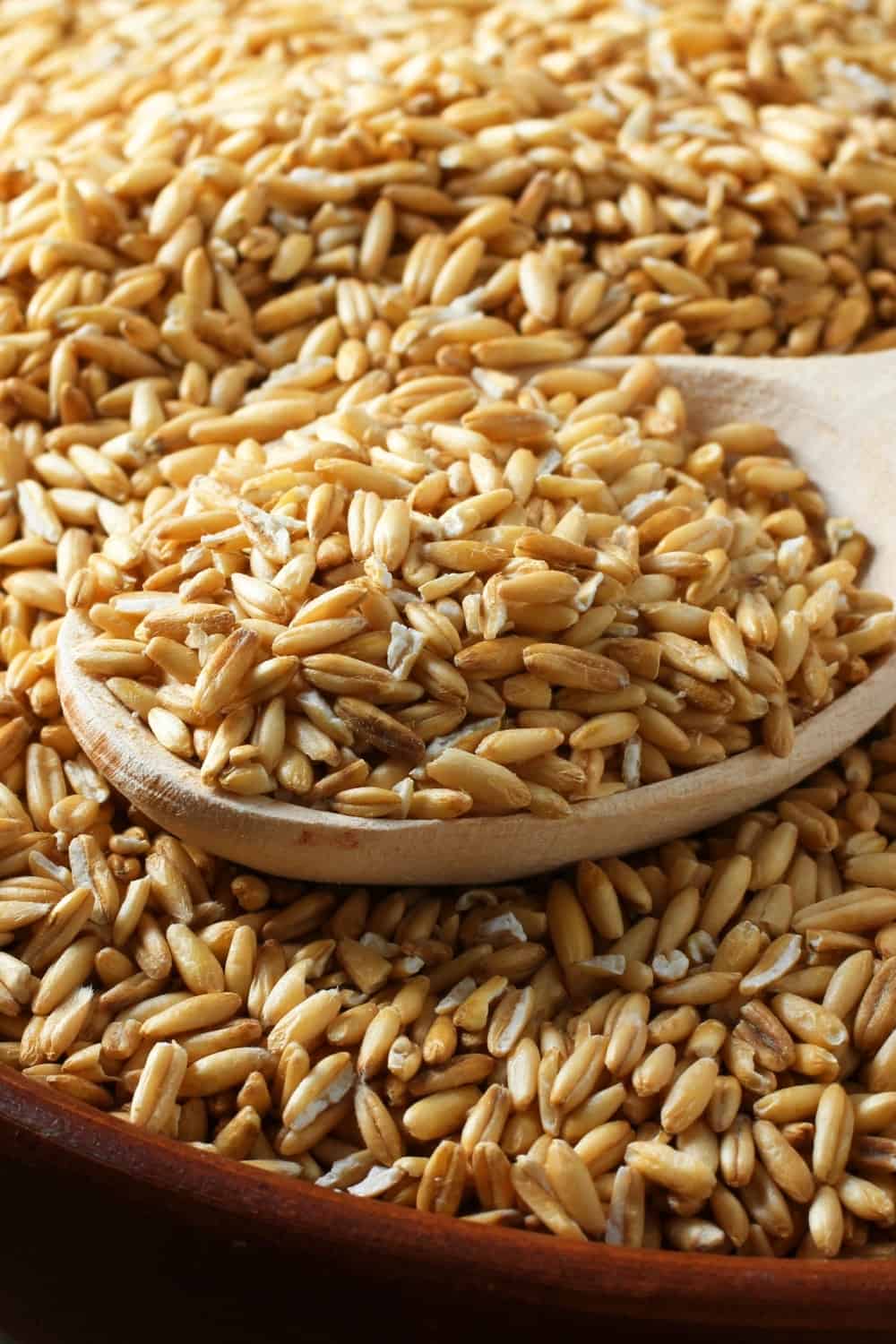
The ancient South American grain known as quinoa became very popular in recent years due to its amazing nutritional value and the fact that it can be added to so many types of dishes.
It can also be a great farro substitute, of course, if you know how to use it.
Pros
• Versatility: Quinoa is a very versatile ingredient that can be incorporated into so many types of dishes, mainly due to its mild flavor that won’t overpower other ingredients.
• Faster Cooking Time: Quinoa cooks faster than farro, so it may be a great option for quick meal prep.
• Protein Powerhouse: White farro contains a lot of protein (about 6 grams per ¼ cup serving), quinoa has a higher amount of protein (about 8 grams of protein).
• Gluten-Free: Unlike Farro, quinoa is gluten-free, which makes it an ideal option for those of you who have gluten intolerance or celiac disease.
Quinoa is the healthiest farro substitute and probably one of the healthiest grains in the world, so this video will show you why it is considered a superfood.
Cons
• Texture: Quinoa is smaller and has a rounder shape, as well as a softer texture compared to farro, which has a chewy texture. In some recipes where the texture is important (like a salad for example), quinoa won’t be an ideal solution.
• Flavor: Just like farro, quinoa has a nutty flavor, but at the same time it is a lot milder. Aside from that, it has a slightly bitter aftertaste which may not be appealing to some people.
• Amount Of Calories: Quinoa is slightly higher in calories when compared to farro.
How To Use Quinoa
Quinoa is a quite versatile ingredient that can be used in many dishes including, soups, stews, salads, grain bowls, as well as pasta, and even baked dishes.
However, when using it as a substitute for farro, you have to take into account that they have slightly different flavors, textures, and cooking processes.
You don’t want to use quinoa in dishes where a nutty flavor and firm texture are important because quinoa is milder and softer than farro.
Aside from that, you have to be cautious about adding too much water when cooking it because quinoa can get mushy.
It cooks faster than farro, so you have to be careful not to overcook it, or it will have an unpleasant gummy texture.
When substituting, the general guideline is to use about 1.5 to 2 cups of cooked quinoa for every cup of cooked farro.
Finally, when it comes to quinoa shelf life, it doesnt go bad so easily, so it is considered quite shelf-stable ingredient.
3. Spelt
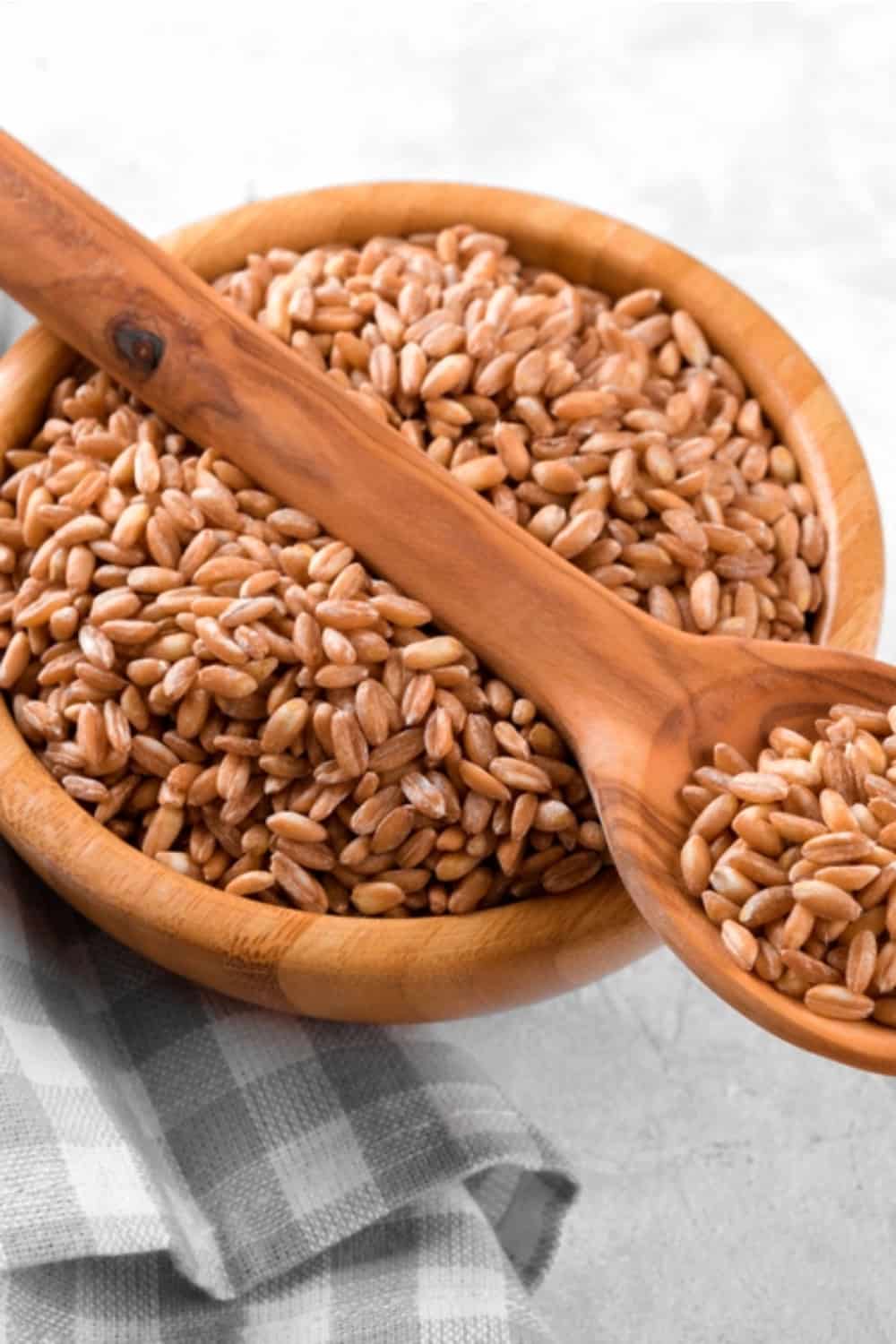
Spelt, also known as spelt berries, are actually not berries but rather kernels of grain. Like farro, they are an ancient type of wheat berry and can be traced back to 5000 BC.
Since they have some other similarities with farro, these two ingredients are interchangeable. So, let’s take a look.
Pros
• Versatility: Spelt can be used in many different dishes, especially those in which farro is used.
• Flavor Profile: Spelt has a similar flavor to farro since it is also nutty to some extent and can add flavor and richness to a variety of dishes.
• Availability: Although it is not as readily available like some other popular types of grains, spelt can be more easily found than farro on the shelves of grocery stores.
• Nutrition: Spelt berries are quite nutritious and they are a great source of protein, fiber, iron, magnesium, zinc, and manganese.
Cons
• Texture: Spelt has a firmer texture than farro, which may not be good in certain dishes where a softer texture is required.
• Cooking Time: Spelt needs a slightly longer time to cook than farro.
• Higher Price: Although you can find spelt more easily in grocery stores, it is more expensive than farro.
• Contains Gluten: Unlike quinoa, spelt isn’t gluten-free, so it may be harder to digest for certain people, especially for those who suffer from gluten intolerance or celiac disease.
How To Use Spelt
When cooked, spelt berries make a great addition to almost any soup and stew, but they also adapt perfectly to any rice-based dish.
However, since spelt berries have a firmer texture, they are much more suitable for grain salads as a substitute for farro which is a softer grain.
If you eventually choose to use spelt as a substitute for farro, you will have to adjust the cooking time because spelt cooks much faster than farro.
Aside from that, you will also have to adjust the amount of water, i.e. the general rule of thumb is to use 2 cups of water for every cup of spelt, while the ratio for farro is 3 cups of water for 1 cup of farro.
I also have to emphasize that, although very similar in flavor, spelt is slightly nuttier and sweeter, so you will have to incorporate other seasonings if you want to adjust the flavor of the dish.
5. Bulgur
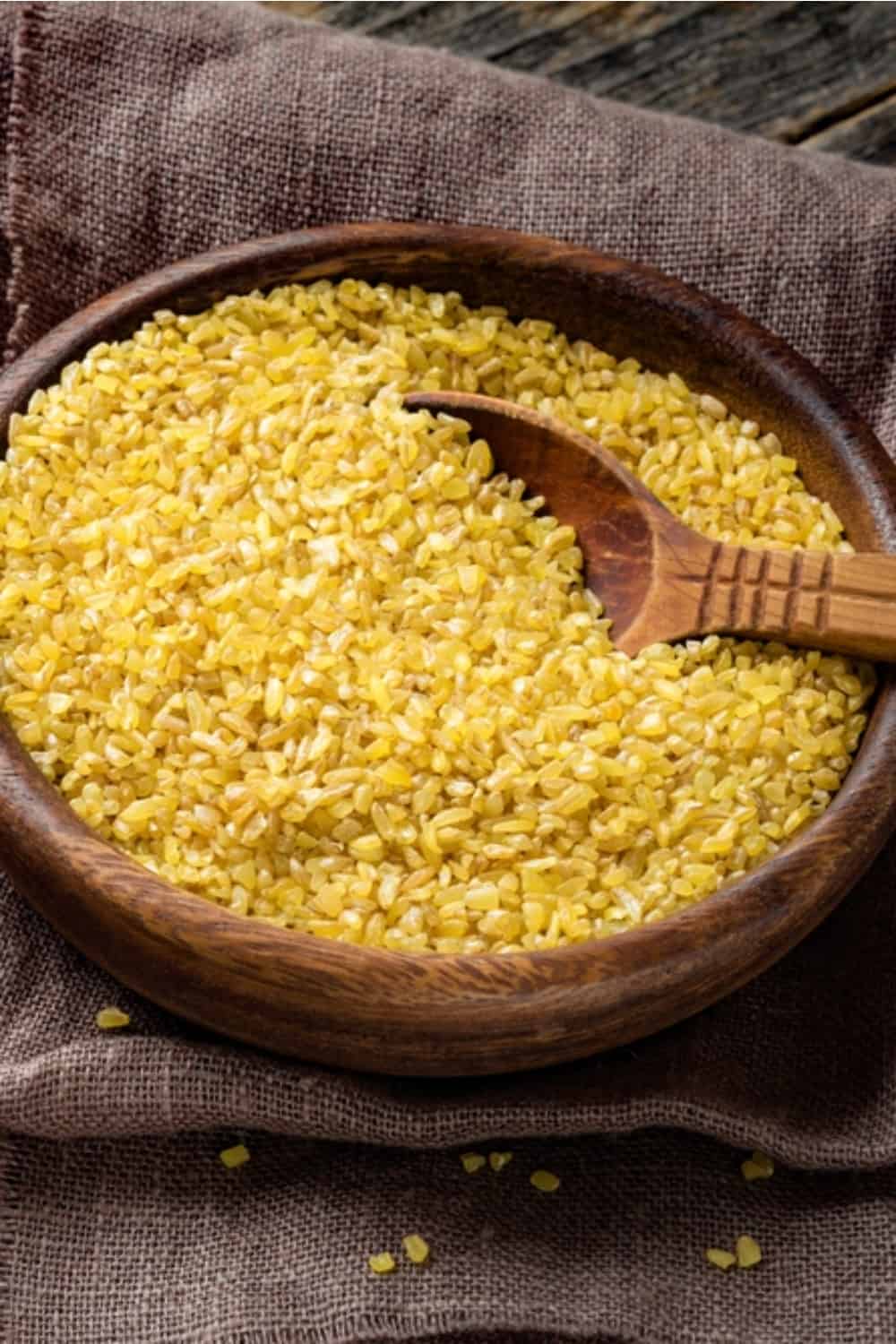
Cracked, partially cooked, and dried wheat berries, bulgur is an ingredient very interchangeable with farro. It is a great option in various types of dishes, but there are also several reasons why it can be a great farro alternative.
Pros
• Doesn’t Need Standard Cooking: Bulgur is quite unique when it comes to its preparation and cooking.
It is not necessary to wash it and you can just put it in a heatproof bowl, cover it with boiling water, and leave it to soak for 20-30 minutes, until tender.
• Similar Flavor Profile: While not exactly the same, bulgur comes quite close to farro in terms of flavor profile since it also has a nutty flavor with slight sweetness and earthiness. However, it is a bit more earthy than farro.
• Lower In Calories: While they have similar amounts of calories, bulgur is slightly lower in calories (around 150 calories per cup) when compared with farro (around 170 calories per cup).
Cons
• Different Texture: Bulgur is softer than farro and tends to get mushy if overcooked. This means that it isn’t an ideal choice for dishes that require a firmer texture, such as grain bowls or salads.
• Less Versatile: Bulgur can also be used in many dishes, but it is predominantly used in Middle Eastern cuisine and it is not as versatile as farro.
• Not So Nutritious: Bulgur also contains a lot of carbohydrates and dietary fiber, but it is not as good a source of micronutrients as farro. (1)
How To Use Bulgur
As already stated above, bulgur doesn’t need standard cooking because you can just cover it with boiled water and let it sit for about 20-39 minutes until tender.
If you decide to cook it, the cooking process will take only about 10-15 minutes and that makes it one of the fastest and easiest grains to cook.
When substituting, you can freely use it in a 1:1 ratio.
You just have to pay attention to the amount of water you use because bulgur tends to absorb more liquid than farro. So, it is best to reduce the liquid by ¼ cup and adjust as needed.
Bulgur can be a great substitute in some recipes like soups and salads, as well as in pilafs and grain bowls.
See Also: 20 Bulgur Substitutes That Are Just As Healthy (Or Even Healthier)
6. Kasha (Buckwheat Groats)

Although kasha can apply to any kind of cooked grain, it usually refers to the pseudocereal buckwheat or its culinary preparations.
This type of kasha can be a great farro alternative in some cases. So, let’s see.
Pros
• Cooking Time: Buckwheat kasha usually cooks for around 15-20 minutes, which is shorter when compared to farro.
• Nutrition: Buckwheat kasha is a great source of various healthful nutrients, but especially a good source of protein, fiber, and complex carbohydrates. It also contains decent amounts of potassium, magnesium, calcium, and iron.
• Gluten-Free: Of course, buckwheat kasha is free of gluten, which makes it a great farro substitute for those of you who suffer from gluten intolerance or celiac disease.
Cons
• Distinct Nutty Flavor: While both farro and buckwheat kasha have a nutty flavor, the kasha flavor is much stronger.
• Softer Texture: Kasha has a softer and more delicate texture than farro, which can be a downside in some dishes where a firmer texture is important.
• Less Available: Farro can also be hard to find, but it is more available in some areas than buckwheat kasha.
How To Use Buckwheat
In order to make buckwheat kasha, you will have to roast and soak buckwheat groats, and then simmer them slowly until they become soft.
Buckwheat kasha cooks faster than farro, so you will have to adjust the cooking time and check it frequently so it doesn’t overcook and become mushy.
When it comes to liquid, buckwheat kasha doesn’t require too much water (no more than 1 ½ cups of water per cup of grain).
Finally, it is best to use kasha in cold dishes like salads and grain bowls where it can be mixed with various veggies, herbs, and dressings for a nutritious and flavorful meal.
It can also be a great substitute for farro in soups and stews where it will add a rich, nutty flavor and a unique texture.
If you are not sure how to make your own kasha, the video below will help you.
7. Teff
Teff is a tropical dark brown grain grown primarily in Ethiopia and it is one of the smallest grains out there.
Since it has some similarities with farro, as well as some benefits in terms of nutrition, it can serve as a decent alternative.
Pros
• Cooking Time: Teff cooks faster than farro; the cooking time varies, i.e. you can cook it for only 8 minutes or up to 20 minutes, depending on the amount of water you add.
• Nutrition: Teff is high in protein, complex carbohydrates, and fiber. It is also rich in B vitamins and is a great source of minerals including copper, calcium, iron, manganese, magnesium, potassium, phosphorus, and zinc.
• Gluten-Free: Teff is naturally gluten-free, making it a great option for those of you who suffer from gluten intolerance or celiac disease.
• Flavor Profile: The flavor profile of teff is much like that of farro since it is also a combination of nutty and sweet flavors, with some earthy undertones.
Cons
• Texture: When compared to farro, teff has a finer texture and becomes sticky if overcooked or not handled properly.
• Availability: It is harder to find teff in some areas of the country. However, it can be purchased online.
• Higher Price: Teff is a more expensive type of grain since it is hard to harvest due to its smaller size.
How To Use Teff
You should pay attention to some factors when using this grain as an alternative.
First, it is not a bad idea to rinse it before cooking to ensure that it doesn’t become sticky. When cooking it, it is important to know that it cooks faster than farro and that it can become too mushy if overcooked. So pay attention to that.
Finally, it is best to use it in cold dishes such as salads and grain bowls, alongside some other veggies, herbs, and dressings.
And, it is a good idea to add it to hearty soups and stews to provide them with a rich, nutty flavor and unique texture.
8. Oat Groats
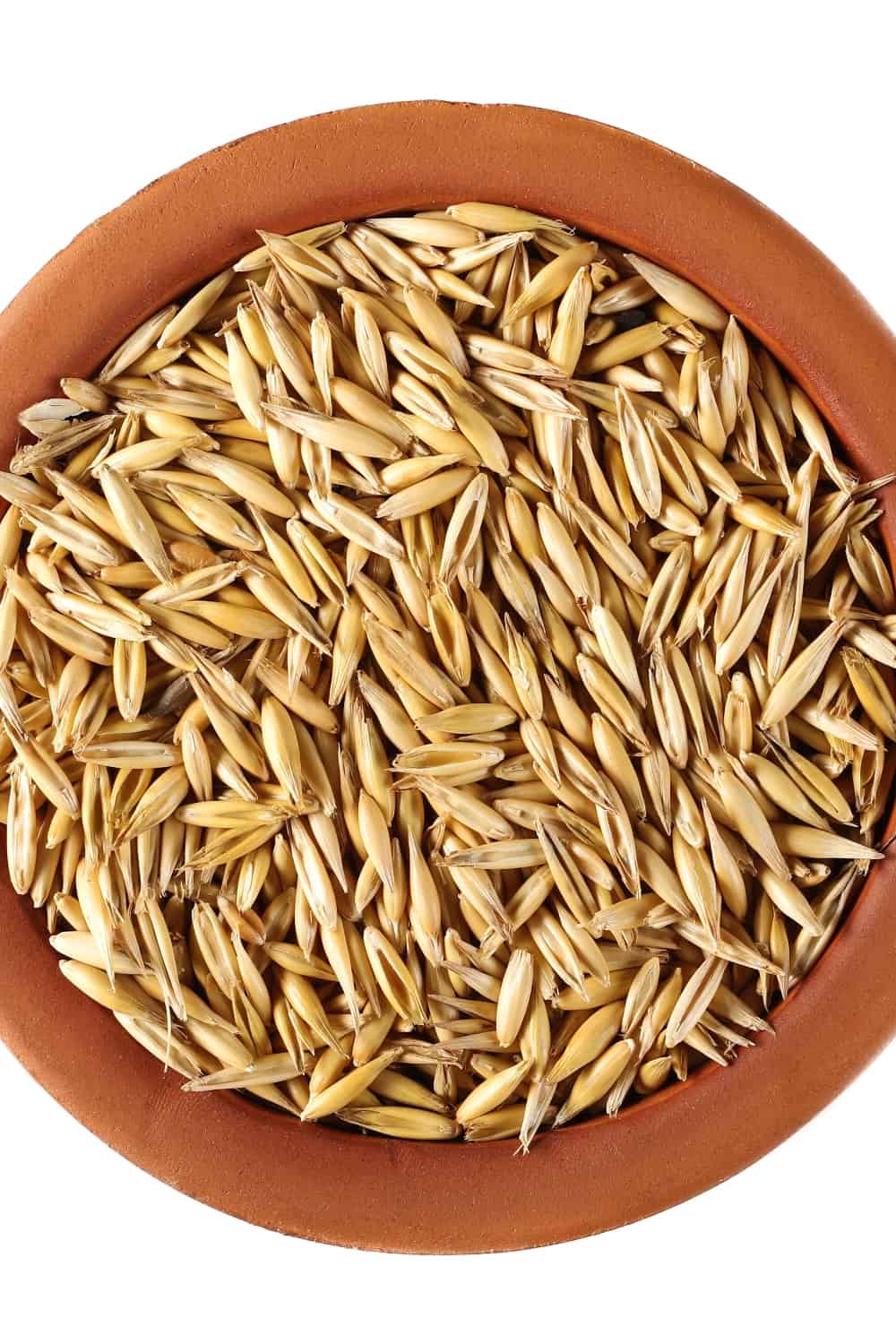
Oat groats are huskless oat kernels, which include the cereal germ, the bran, and the endosperm of the grain. Groats are the most intact form of grain and, therefore, packed with dietary fiber and extremely nutritious.
They can also serve as a great substitute for farro.
Pros
• Similar Flavor And Texture: Like farro itself, oat groats also have a mild, nutty flavor with sweet undertones. Aside from that, these groats also have a chewy texture to some extent.
• Nutrition: According to FDA, oat groats are a great source of protein, complex carbs, and fiber, as well as some micronutrients, including calcium, iron, and potassium.
• Versatility: Oat groats are considered a very versatile ingredient since they can be used in both sweet and savory dishes.
• Availability: Unlike farro, oat groats are highly available at most grocery stores and supermarkets in the US.
Cons
• Cooking Time: Oat groats require quite a long cooking time, especially when compared with other types of grains including farro.
• Cross-Contamination: Although they are naturally gluten-free, oat groats may be cross-contaminated with gluten during processing.
How To Use Oat Groats
Since they have a similar flavor and texture to farro, as well as high nutritional value, oat groats can be a great substitute in some dishes.
Since they require longer cooking time than farro, you will have to adjust it according to the recipe. It is not a bad idea to soak them overnight before cooking to accelerate the cooking time.
Also, when cooking oat groats, they may require more liquid than farro, but it is best to follow the recipe instructions for the best results.
Oat groats can be used in some recipes instead of farro, and they are especially suitable for stews and porridge. Aside from that, you can also use them in salads, soups, and grain bowls.
9. Rye Berries

Rye berries are the whole-grain form of rye with only the hull removed. They are not as well known as other grains, but they are highly nutritious, versatile, and can be a good substitute for farro.
Pros
• Similar Flavor: Like farro, rye berries have a slightly nutty flavor that can complement a variety of dishes.
• Nutrition: Rye berries are a good source of complex carbohydrates, dietary fiber, and protein, as well as some micronutrients like calcium, iron, and potassium.
Cons
• Contain Gluten: Rye berries are not gluten-free, which can be problematic for those of you with celiac disease or gluten intolerance.
• Different Texture: Rye berries have a tougher texture than farro, which may not be suitable for some types of dishes.
• Less Available: In some areas, rye berries can be harder to find than farro.
How To Use Rye Berries
They are not the perfect substitute for farro since they contain gluten and have a different texture, but rye berries can serve decently in some cases.
They can be used in some dishes like salads, soups, and stews, but you will have to be careful when cooking them because they require a different cooking time.
To use them as a substitute, you will have to boil them over high heat. After that, they should simmer for at least an hour.
If you decide to use a slow cooker, you will have to cook them on high heat for 2-3 hours. If you have time, you can also put them on a low setting and let them cook for 5-6 hours.
Also, my recommendation is to consider pairing them with some ingredients that will complement their nutty, slightly sour flavor, such as root veggies or savory sauces.
10. Rice

Unlike some other grains on this list, rice is well-known among many people, and it is actually one of the most eaten foods in the world. It is the seed of the grass species Oryza sativa and it is most popular in Asian countries.
Rice can be a decent farro alternative and you will soon learn why.
Pros
• Flavor: Two most frequently used types of rice are white rice and brown rice and they both have a mild nutty flavor, similar to farro. However, it is better to choose brown rice because it is closer to farro in terms of nuttiness.
• Gluten-Free: Rice is free of gluten, so it is a great substitute for those of you who can not consume it.
• Availability: Rice is much more available than farro and it can be found in every grocery store and supermarket all around the world.
• Less Expensive: Aside from being highly available, rice is also more affordable than farro.
Cons
• Texture: Rice has a softer texture than farro, which may not be appealing to some people.
• Fiber Content: If you are looking for an ingredient that can provide you with a lot of fiber, rice won’t be your ideal solution because its fiber content is way lower than farro. (2)
• Glycemic Index: Although the glycemic index of rice varies depending on the type, in general, rice has a higher glycemic index than farro. (3) (4)
A high glycemic index of certain food means that, when you consume it, your blood sugar levels will spike quickly and that is not a good thing, especially for diabetics and pre-diabetics.
How To Use Rice
First, there are many types of rice, so it is important to choose the right variety.
From my experience, short-grain and medium-grain varieties are the best substitutes for farro in recipes because they have similar textures and starchiness.
After you choose the right rice, it is important to rinse it properly so it doesn’t become sticky.
When you cook it, you should bear in mind that it requires less liquid and less time to cook. If you add too much water or cook it for too long, it might become too soft or even mushy.
Finally, you can use rice in many different recipes including salads, soups, and stews. Rice can also be used instead of farro in rice bowls, rice pilaf, or in risotto.
If you want to know how to make a delicious and healthy rice bowl that is also quite inexpensive, check out this video.
Sources:
1. NOURISH by WebMD (2022), Health Benefits of Bulgur Wheat, accessed 7 March 2023
2. MedicalNewsToday (2022), What to know about rice, accessed 7 March 2023
3. EVERYDAY HEALTH (2020), 8 Whole Grains That Can Help Prevent or Manage Type 2 Diabetes, accessed 7 March 2023
4. National Library of Medicine (2020), Glycemic Index of Wheat and Rice are Similar When Consumed as Part of a North Indian Mixed Meal, accessed 7 March 2023
